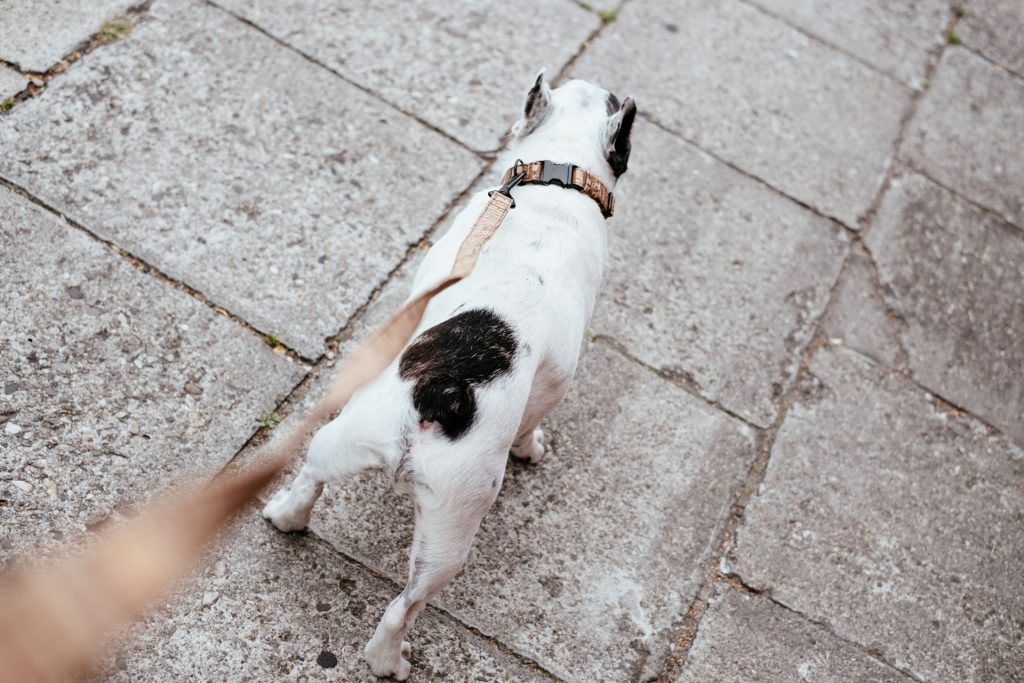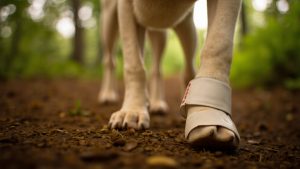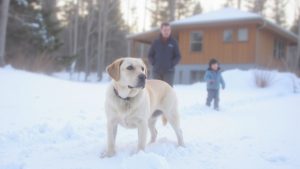
When a once-energetic dog begins hesitating before jumping into the car or struggles to rise after a nap, hip dysplasia might be the culprit. This common skeletal condition occurs when a dog’s hip joint doesn’t develop properly, causing the ball and socket to fit together poorly or loosely.
Large breed dogs like German Shepherds, Labrador Retrievers, and Rottweilers face higher risks, but hip dysplasia can affect dogs of any size. Over time, the joint deterioration leads to pain, inflammation, and eventually canine arthritis. The condition impacts thousands of dogs annually, but with proper care and management, most can maintain a good quality of life.
This article explores the causes, symptoms, and treatment options for this challenging but manageable condition.
What Causes Hip Dysplasia in Dogs?
Hip dysplasia develops when the ball and socket joint of a dog’s hip forms improperly during growth. Genetics is the primary cause, but several factors contribute to the condition’s development and severity.
The genetic blueprint for hip dysplasia can be inherited, explaining why certain breeds face higher risks. Labradors, German Shepherds, Rottweilers, Saint Bernards, Bulldogs, and Great Danes are particularly susceptible due to their genetic makeup. Research shows that dogs with parents who have hip dysplasia are significantly more likely to develop the condition themselves.
Beyond genetics, environmental factors play a crucial role in whether hip dysplasia will manifest and its potential severity:
- Rapid growth rate: Puppies growing too quickly may develop skeletal structures improperly, stressing forming joints.
- Improper nutrition: Diets high in calories or with imbalanced calcium-phosphorus ratios can cause skeletal abnormalities during critical growth phases.
- Excess weight: Studies show that overweight puppies are nearly twice as likely to develop hip dysplasia compared to those at healthy weights.
- Inappropriate exercise: Too much high-impact activity during skeletal development can damage joint structures and worsen existing joint laxity.
During normal joint development, the femoral head (ball) should fit snugly into the acetabulum (socket) of the pelvis. In puppies with hip dysplasia, this alignment fails. The resulting joint looseness causes abnormal wear on cartilage surfaces, leading to inflammation and eventual osteoarthritis.
While large and giant breeds have higher incidence rates, small breeds are not immune. Yorkshire Terriers, Pugs, and French Bulldogs can also develop hip dysplasia, though it’s less common in smaller dogs. The severity of symptoms doesn’t always match the radiographic appearance of the joints—some dogs with significant dysplasia may show minimal discomfort, while others with milder changes may experience considerable pain.
Controlling a puppy’s growth rate through proper feeding practices remains one of the most effective ways to reduce hip dysplasia risk in predisposed dogs. Research indicates that puppies fed unlimited food develop hip dysplasia at twice the rate of puppies fed measured meals, emphasizing the importance of careful nutrition management during development.
How Do You Spot Signs of Hip Dysplasia in Dogs?

Recognizing early signs of hip dysplasia in dogs can lead to faster intervention and better quality of life. Some dogs may show symptoms as young as four months of age, while others might not display noticeable signs until the condition progresses with age. Key symptoms to watch for include:
- Movement changes: Dogs may develop a noticeable limp or show reluctance to move as freely as before.
- Bunny hopping: Running with both hind legs moving together in a hopping motion, especially when climbing stairs.
- Difficulty standing up: Struggling to rise from a sitting or lying position, particularly after resting.
- Stiffness: Appearing stiff or uncomfortable after sleeping or during cold weather.
- Reluctance to jump: Hesitation or refusal to jump into cars or onto furniture.
- Trouble with stairs: Avoiding stairs or showing visible discomfort when navigating them.
- Pain response: Flinching or showing discomfort when their hip area is touched.
- Muscle changes: Decreased muscle mass in the hind legs with noticeable enlargement of shoulder muscles as compensation.
- Reduced activity: Becoming less interested in walks, play, or regular activities.
- Behavioral changes: Showing irritability, decreased energy, or other personality changes.
Many dogs instinctively hide their pain, making hip dysplasia challenging to detect early. Pay close attention to subtle changes in a dog’s behavior or mobility patterns. A dog that suddenly stops jumping onto the couch, seems less enthusiastic about walks, or takes longer to get up might be showing early signs of hip discomfort.
The severity of symptoms can vary widely. Some dogs may show only mild, occasional lameness, while others might experience significant mobility issues. Signs may worsen after exercise or during cold, damp weather when joint pain typically intensifies.
What Are the Best Dog Hip Dysplasia Treatment Options?

Treating dog hip dysplasia requires a tailored approach based on the dog’s age, weight, and severity of the condition. A comprehensive treatment plan often combines several strategies to maximize comfort and mobility while slowing the progression of joint damage.
Conservative Management Approaches
For mild to moderate cases of hip dysplasia, non-surgical interventions can significantly improve quality of life. Weight management stands at the forefront of these approaches, as excess pounds place additional stress on already compromised joints. Even a modest 10% reduction in weight can reduce pain and improve mobility in affected dogs.
Physical therapy offers another effective non-surgical option. Controlled exercise programs help strengthen the muscles around the hip joint, providing better support while improving range of motion. This might include:
- Leash-assisted walking on soft, even surfaces
- Hydrotherapy or swimming, which allows muscle strengthening without joint stress
- Passive range-of-motion exercises to maintain joint flexibility
Joint supplements containing glucosamine, chondroitin, and omega-3 fatty acids may help nourish cartilage and reduce inflammation. Green-lipped mussel extract has also shown promising results in supporting joint health. These supplements work best when started early and continued long-term.
Medical Management
Pain management is crucial for dogs with hip dysplasia. Veterinarians may prescribe non-steroidal anti-inflammatory drugs (NSAIDs) to reduce inflammation and alleviate discomfort. These medications can dramatically improve a dog’s mobility and quality of life when used appropriately under veterinary supervision.
In some cases, additional pain medications may be prescribed to work alongside NSAIDs. For more severe pain, veterinarians might recommend joint injections that deliver anti-inflammatory medication directly to the affected area, providing targeted relief that can last for months.
Surgical Options
When conservative approaches don’t provide adequate relief, surgical intervention may be recommended. The appropriate procedure depends on the dog’s age, size, and the extent of joint damage:
- Femoral head ostectomy (FHO): Involves removing the ball portion of the hip joint, creating a “false joint” as scar tissue forms. This procedure can benefit dogs of all ages and sizes but is particularly suitable for smaller dogs.
- Double or Triple Pelvic Osteotomy (DPO/TPO): Best for younger dogs (under 10 months) with minimal arthritis. This procedure improves the alignment and stability of the hip joint by cutting and repositioning the pelvic bones.
- Total Hip Replacement (THR): Often considered the gold standard for treating severe hip dysplasia. It involves replacing the entire hip joint with artificial components, offering excellent restoration of normal function in many cases.
Recovery from hip dysplasia surgery typically takes several weeks to months, with physical rehabilitation playing an important role in the healing process. While surgical options tend to be more expensive, they can provide dramatic improvements in comfort and mobility for dogs with debilitating hip dysplasia.
| Treatment Option | Benefits | Limitations |
|---|---|---|
| Femoral Head Ostectomy (FHO) | Reduces discomfort, creates ‘false joint’ | Normal hip function unlikely to be restored |
| Double or Triple Pelvic Osteotomy (DPO/TPO) | Improves alignment and stability | Best for dogs under 10 months, requires surgery |
| Total Hip Replacement (THR) | Restores normal function, most effective | Most expensive, requires custom implants |
| Physical Therapy | Strengthens muscles, improves support | Requires consistent implementation |
| NSAIDs | Reduces inflammation and pain | Long-term use may have side effects |
| Weight Management | Reduces joint stress, enhances mobility | Requires ongoing monitoring |
Integrating Treatment Approaches
Most successful treatment plans combine multiple approaches. For example, a moderately affected older dog might benefit from weight management, joint supplements, controlled exercise, and occasional pain medication. Meanwhile, a young dog with severe dysplasia might need surgical correction followed by physical therapy and nutritional support.
The timing of intervention significantly impacts outcomes. Early detection and treatment can slow disease progression and minimize joint damage. Regular veterinary check-ups help monitor the condition and allow for adjustments to the treatment plan as needed.
With appropriate management, many dogs with hip dysplasia can lead comfortable, active lives despite their condition. Working closely with a veterinarian to develop and refine a comprehensive treatment approach gives dogs the best chance for maintaining mobility and quality of life.
Can You Prevent Hip Dysplasia or Slow Its Progression?

While genetics plays a dominant role in hip dysplasia development, there are several proactive measures dog owners can take to minimize risk factors and slow the condition’s progression. Preventive care is especially important for breeds predisposed to joint problems.
Responsible Breeding Practices
Effective prevention starts before a puppy is born. When acquiring a dog from a breed with high hip dysplasia rates, it’s crucial to work with breeders who conduct proper screening. Responsible breeders participate in programs like the Orthopedic Foundation for Animals (OFA) evaluation, certifying dogs with normal hip structures before breeding them.
Nutrition Management
Diet plays a crucial role in joint development, particularly during growth. Large and giant breed puppies should receive specially formulated food that controls growth rate. Unlike standard puppy food that promotes rapid development, breed-specific formulas contain balanced calcium-to-phosphorus ratios, allowing joints to develop at an appropriate pace.
For adult dogs, maintaining ideal body weight is perhaps the most important factor in hip dysplasia prevention. Each excess pound creates additional stress on already vulnerable hip joints, accelerating deterioration and increasing pain.
Appropriate Exercise Protocol
Regular activity strengthens muscles around the hip joint, but certain exercises can worsen hip dysplasia. Avoid high-impact activities like jumping, stair climbing, or sudden stop-and-start movements, especially in growing puppies. Instead, focus on low-impact exercises like swimming, which builds muscle without stressing joints.
For puppies in high-risk breeds, limit rough play sessions and postpone intense physical activities until skeletal maturity (typically 12-18 months of age).
Early Detection and Intervention
Regular veterinary examinations can identify early signs of hip laxity before significant joint damage occurs. Veterinarians can perform screening tests like the Ortolani maneuver to detect abnormal hip movement in puppies as young as 16 weeks. Early detection allows for prompt intervention with joint supplements, weight management protocols, and appropriate exercise plans.
Slowing Progression in Diagnosed Dogs
After diagnosis, several approaches can slow the progression of hip dysplasia. Joint supplements containing glucosamine and chondroitin may help maintain cartilage health and reduce inflammation when started early. Physical therapy techniques, including targeted exercises that strengthen muscles supporting the hip joint, can improve stability and reduce pain.
Regular veterinary monitoring every six months allows for adjustments to the management plan as the condition evolves. This proactive approach helps minimize joint deterioration and maintains a dog’s quality of life for as long as possible.
Helping Your Dog Thrive With Hip Dysplasia
Although hip dysplasia can affect dogs of all breeds and ages, a proactive approach can significantly impact well-being. By collaborating closely with a veterinarian, prioritizing early detection, and committing to weight management and smart exercise, a dog has the best chance to stay active and comfortable.
Tools like the Halo Collar can assist in managing hip dysplasia by enabling safe, controlled movement outdoors. With customizable boundaries and activity tracking, Halo supports low-impact exercise routines—allowing dogs to enjoy fresh air and gentle walks without the risks of overexertion or unexpected strain on their joints. Comparable pet-safety solutions can also be explored to offer similar benefits.
With ongoing care and the right resources, owners can help dogs navigate hip dysplasia’s challenges while preserving their enthusiasm for exploration and play. For more tips on canine health and wellness, visit the Dog Health page.





